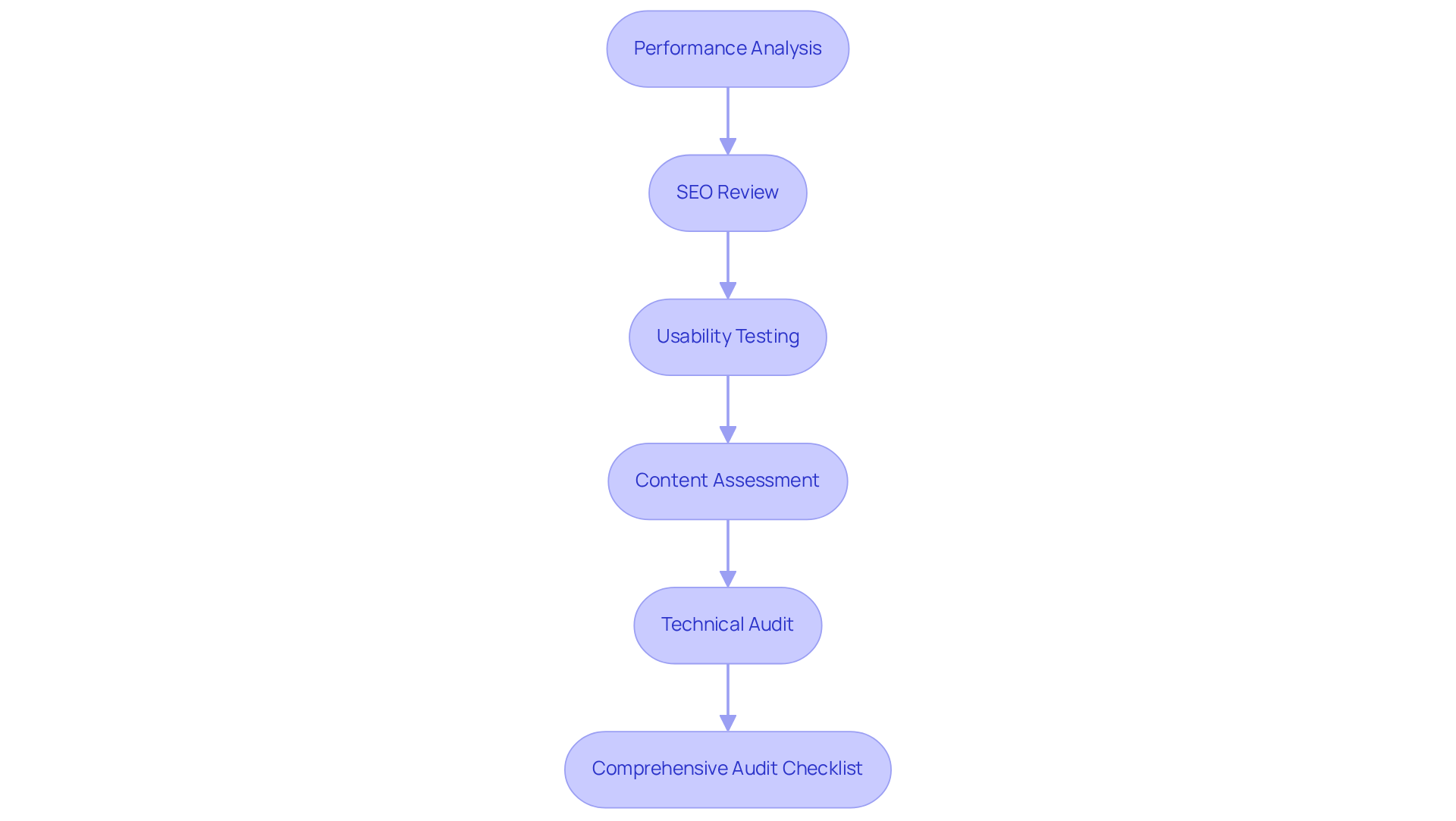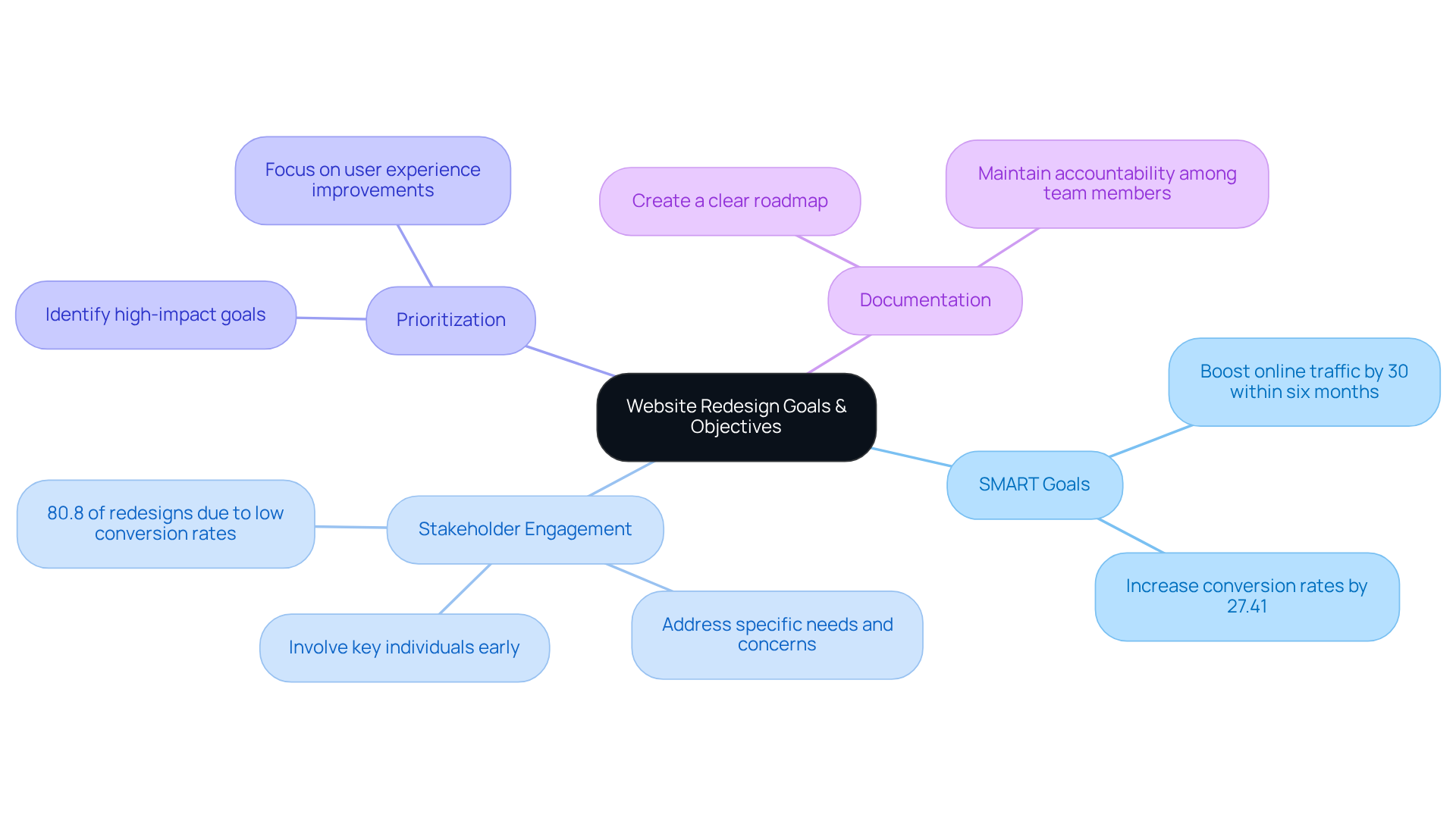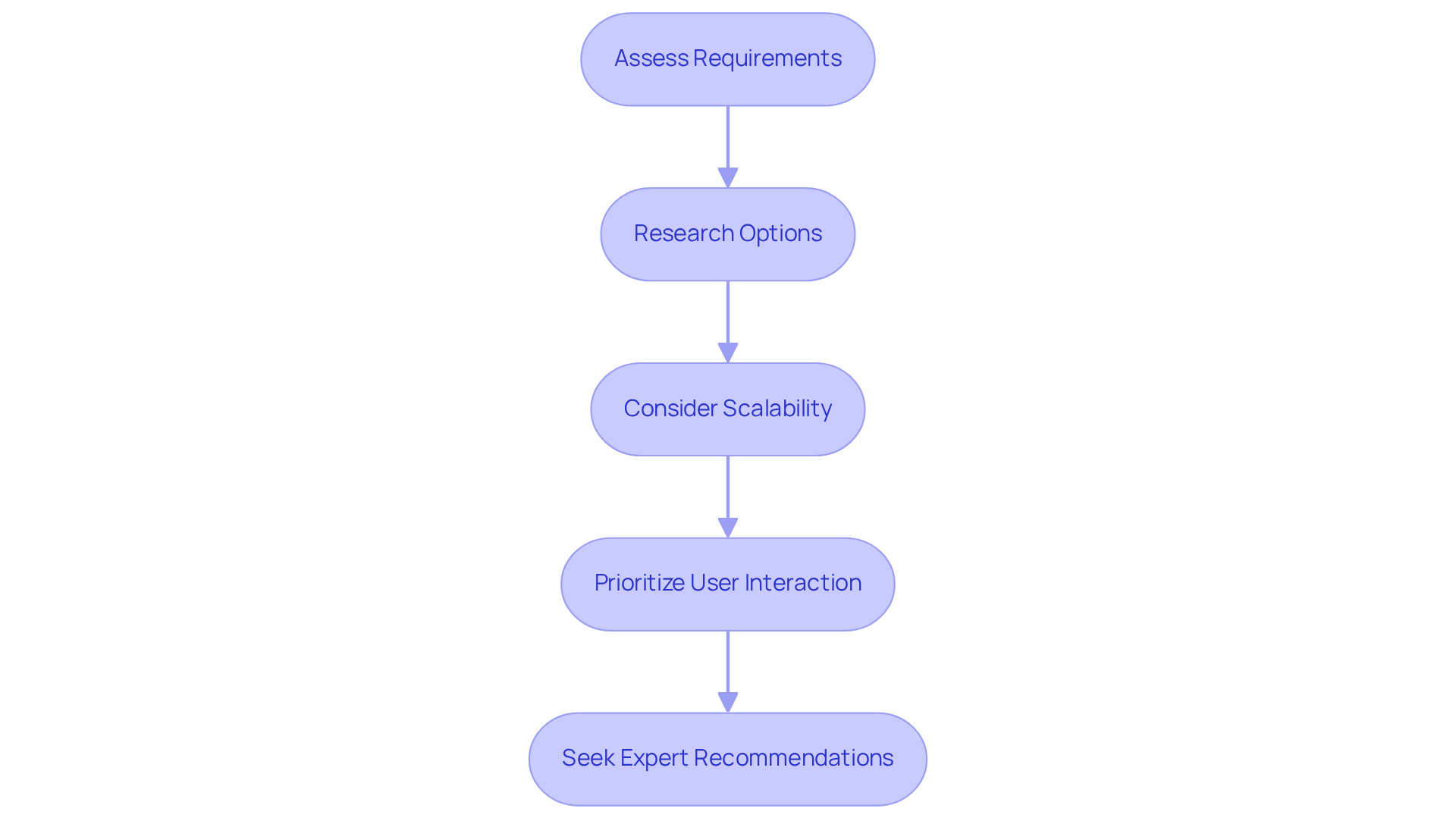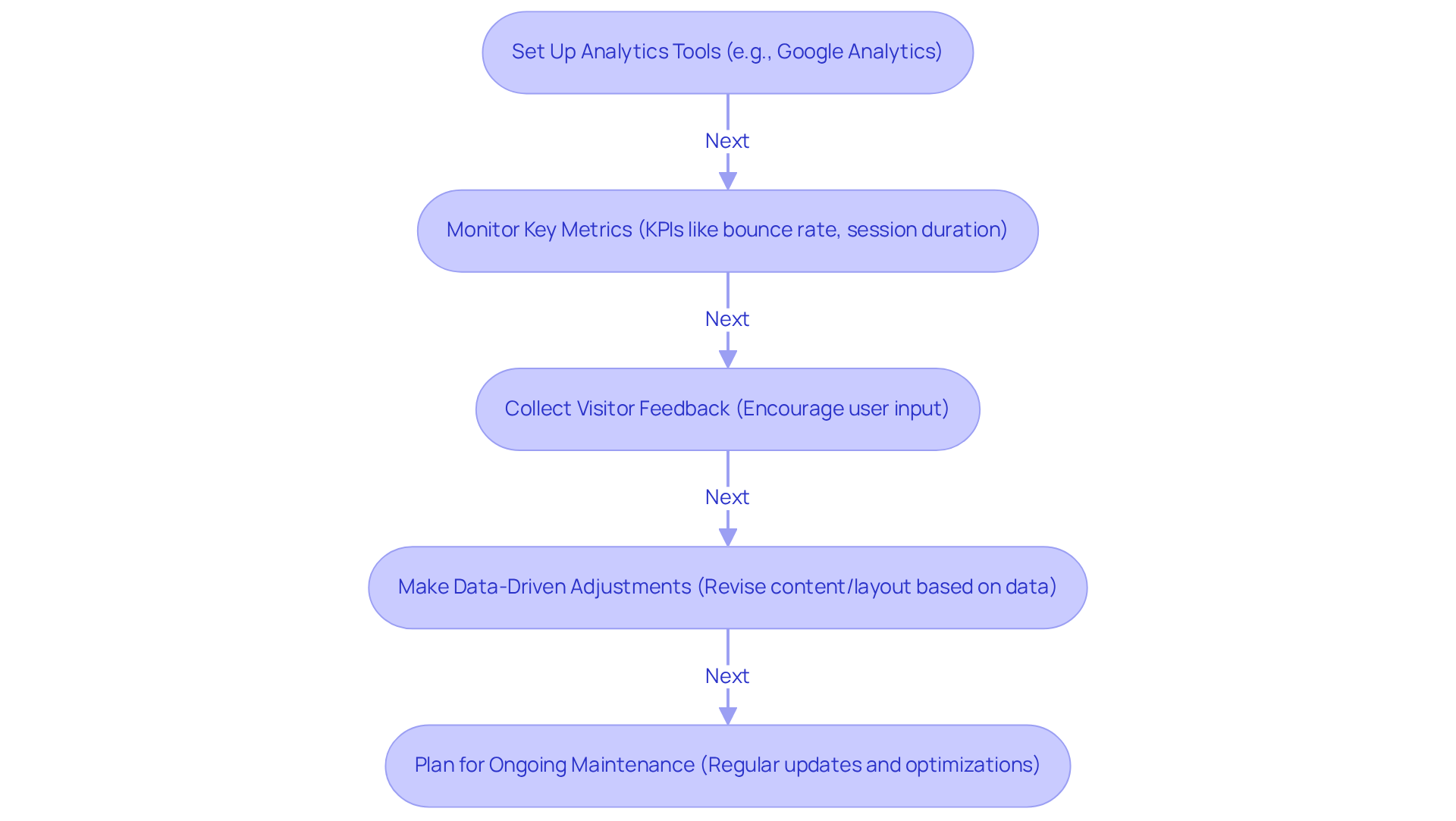Overview
Redesigning a website can often feel overwhelming, especially for tech startup founders striving to meet user expectations. It's crucial to recognize that understanding user needs is not just a step in the process; it's the foundation of a successful redesign. Without this understanding, the risk of misalignment with user expectations looms large, leading to frustration and disengagement.
Therefore, conducting thorough audits becomes essential, allowing you to pinpoint areas that truly need attention. Setting clear goals is another vital step. These goals should not only reflect your business objectives but also resonate with the users you aim to serve.
Choosing the right tools can further ease this journey, ensuring that your efforts translate into meaningful improvements. Prioritizing user experience throughout the redesign process is paramount, as it directly influences how users interact with your site.
Finally, the importance of continuously monitoring performance cannot be overstated. This ongoing assessment ensures that your redesign effectively meets business objectives and enhances user engagement. Remember, you are not alone in this journey; we are here to support you every step of the way.
Introduction
A website redesign can be a transformative journey for any business, yet many founders find themselves overwhelmed by the complexities involved. This process is not merely about enhancing user experience or modernizing aesthetics; it also addresses critical functionality and aligns with evolving business goals. Have you ever wondered how to ensure that your redesign transcends cosmetic changes, becoming a strategic move that truly drives engagement and growth? This guide explores six essential steps designed to empower businesses like yours to effectively revamp their online presence, ensuring a successful and impactful transition. Together, we can navigate this journey, transforming challenges into opportunities for growth.
Understand the Purpose of a Website Redesign
Before embarking on a website redesign, it’s important to understand the motivations behind this initiative. Many founders find themselves facing the challenge of enhancing client experience with a website redesign, refreshing outdated aesthetics, improving functionality, or aligning with new business objectives. At RNO1, we recognize that a deep understanding of what drives individuals is essential for crafting effective strategies that yield rapid ROI. Our services, including UX & UI Design and Digital Strategy, are thoughtfully designed to empower brands through user-centric approaches. To truly grasp the purpose of your redesign, consider the following steps:
- Identify Pain Points: Engage with users and stakeholders to gather feedback that highlights issues with the current platform. This user-focused method ensures that the revamp addresses real needs, fostering a sense of connection and understanding.
- Analyze Competitors: Take a moment to explore competitors' websites. This can reveal trends and features that may enhance your site, helping you remain competitive in the ever-evolving digital landscape.
- Set Clear Objectives: Define what success looks like for your revamp—whether it’s increased traffic, improved conversion rates, or enhanced user engagement. Aligning these objectives with your overall business strategy is crucial for creating .
By establishing a clear purpose, you can ensure that the redesign process remains focused and aligned with your overarching business strategy. Successful case studies from RNO1 illustrate how targeted redesigns can lead to greater engagement and increased sales, showcasing the effectiveness of our compassionate approach.
Conduct a Comprehensive Website Audit
Conducting a thorough audit of your online platform is essential for uncovering opportunities for improvement in your website redesign. Many founders face the challenge of understanding how to enhance their digital presence. This journey can feel overwhelming, but with the right steps, a website redesign can help transform your platform into a more effective tool for engagement.
Performance Analysis: Begin by utilizing tools like Google Analytics and VWO to evaluate traffic patterns, bounce rates, and visitor behavior. Did you know that in 2025, average bounce rates for websites are expected to hover around 50%? This statistic underscores the importance of . Additionally, consider that 75% of individuals never go beyond the first page of search results, which highlights the need for improvement in how users interact with your site.
SEO Review: Next, assess on-page SEO factors, such as meta tags, keyword usage, and backlinks. Regular audits are essential for website redesign, as they often reveal that 95% of pages lack backlinks. This finding emphasizes the necessity of building a robust link profile to enhance visibility and credibility.
Usability Testing: Conduct usability tests to evaluate the site's navigation, layout, and overall visitor experience. Experts suggest that websites designed with large fonts and simple layouts significantly enhance usability, especially for older adults. Moreover, with 92.3% of individuals accessing the internet via mobile devices, a website redesign that ensures a mobile-friendly design is not just beneficial—it's essential.
Content Assessment: Review your existing content for relevance, quality, and alignment with your current branding. Long-form content (over 3,000 words) tends to receive 77.2% more backlinks than shorter pieces, making it a valuable asset for your SEO strategy.
Technical Audit: Finally, identify any technical issues, such as broken links, slow loading times, and mobile responsiveness. As mobile devices account for 60% of all web traffic, ensuring a seamless mobile experience is crucial for retaining visitors.
Comprehensive Website Audit Checklist:
- Analyze traffic patterns and bounce rates.
- Review on-page SEO elements.
- Conduct usability tests with actual participants.
- Assess content quality and relevance.
- Check for technical issues and mobile responsiveness.
As you document your discoveries related to the website redesign, you'll gain a clearer understanding of what needs enhancement in your updates. This organized approach not only improves user experience but also aligns with best practices in digital marketing, ensuring your platform meets the evolving needs of users. Remember, you are not alone in this journey; with each step, you are creating a more engaging and supportive online presence.

Define Clear Goals and Objectives for the Redesign
When embarking on a website redesign, it’s essential to define clear goals and objectives that align with your vision. Many founders face the challenge of creating a focused strategy that truly reflects their business aims. This uncertainty can lead to frustration and missed opportunities. But don’t worry; there are effective strategies to guide you through this process.
First, consider setting SMART goals. This means ensuring your objectives are Specific, Measurable, Achievable, Relevant, and Time-bound. For instance, aim to 'Boost online traffic by 30% within six months of launch.' This clarity not only helps you track progress but also allows you to celebrate your successes along the way.
Next, engaging stakeholders is crucial. Involving key individuals in the goal-setting process fosters alignment and buy-in. By reaching out early, you can uncover specific needs and concerns that are essential for achieving your project objectives. Research shows that 80.8% of website redesign projects are initiated due to low conversion rates, emphasizing the importance of stakeholder input. Additionally, it’s important to note that 52% of individuals are less inclined to engage with a business due to poor mobile interactions. This highlights how should be at the forefront of your improvement objectives.
Prioritizing your objectives is another essential step. Identify which goals hold the most weight for your business and prioritize them. For example, a case study on NYLC revealed a 27.41% increase in conversion rates after a revamp focused on user experience and stakeholder feedback. Strategies such as enhancing mobile responsiveness and streamlining navigation contributed significantly to this success.
Finally, document your goals. Creating a clear document outlining all objectives serves as a roadmap, helping maintain focus and accountability among your team members. This not only keeps everyone aligned but also reinforces the commitment to your shared vision.
By setting clear objectives and involving stakeholders, you can cultivate a focused strategy that aligns with your business aims, ultimately enhancing user experience and driving growth. As Jared Schwitzke wisely noted, RNO1's design-first mindset leads to impactful results, underscoring the importance of a design-focused approach in stakeholder engagement and goal setting. Together, we can navigate this journey and achieve the success you envision.

Choose the Right Tools and Technologies for Implementation
Selecting the right tools and technologies for your redesign can feel overwhelming, but it's essential for achieving your goals. Many founders face the challenge of making choices that truly align with their vision. This is where thoughtful selection becomes crucial.
First, assess your requirements. Clearly identifying the specific features and functionalities needed for your website redesign is a foundational step. This clarity ensures that your choices are in harmony with your business objectives.
Next, research your options. Dive into various content management systems (CMS), design tools, and development frameworks that meet your needs. For instance, WordPress, which supports over 43% of online platforms, offers flexibility and scalability, making it a popular choice among many.
Consider scalability as well. Opt for technologies that can grow alongside your business. With 28% of all , selecting scalable solutions is vital for accommodating future needs and traffic increases.
User interaction is another key area. Prioritize tools that enhance participant satisfaction. A notable 61% of individuals expect to find what they seek within five seconds of arriving on a website. This makes usability a crucial aspect of your decision-making process. Moreover, 40% of visitors will abandon a site if it takes longer than three seconds to load. This statistic underscores the importance of speed in delivering a positive overall experience.
Lastly, seek expert recommendations. Consulting with web development professionals or agencies can provide valuable insights into the best tools for your project. Their expertise can guide you through the myriad of options available, ensuring you make informed decisions.
By carefully choosing the appropriate tools and technologies, you can set your transformation up for success, ultimately improving engagement and fostering growth. Remember, slow-loading websites can cost retailers an estimated $2.6 billion in lost sales annually. This highlights the financial implications of not prioritizing speed in your redesign. You're not alone in this journey; together, we can navigate these choices and set your business on a path to success.

Prioritize User Experience and Conduct Thorough Testing
To prioritize user experience and conduct thorough testing, it's essential to recognize the challenges that many tech startup founders face. You may feel overwhelmed by the need to create a platform that truly resonates with your audience. It’s a common pain point, but there’s a way forward that can alleviate this stress.
- Create User Personas: Start by developing detailed profiles of your target audience. This will guide and ensure that you are meeting their needs.
- Design Prototypes: Next, create wireframes and prototypes. Visualizing the new design allows you to gather valuable feedback from your audience, making them feel included in the process.
- : Evaluate these prototypes with actual participants. This step is crucial to identify pain points and areas for improvement, ensuring that your platform is user-friendly.
- Iterate Based on Feedback: Use the insights gained from testing to refine your design. This iterative process is vital to creating a product that truly meets user expectations before final implementation.
- Perform Cross-Device Testing: Finally, ensure that your platform operates effectively across various devices and browsers. This attention to detail can significantly enhance user satisfaction.
By concentrating on client experience and performing comprehensive testing, you can develop a platform through a website redesign that not only resonates with your audience but also fulfills their needs. Remember, each step you take is a step towards creating a supportive and engaging environment for your users.
Launch the Redesigned Website and Monitor Performance
After launching your website redesign, you may find yourself wondering how well it’s performing. This concern is completely valid, as monitoring its performance is essential to ensure it meets your established goals. Let’s explore some steps together that can help you navigate this process with confidence:
- Set Up Analytics Tools: Consider implementing tools like Google Analytics to monitor visitor behavior, traffic sources, and conversion rates. Setting up Google Analytics is straightforward and free, requiring only a Google account. This tool offers essential insights into how visitors interact with your site, helping you to understand their engagement. As we look ahead to 2024, it’s noteworthy that around 64.95% of worldwide website traffic comes from mobile devices. This statistic emphasizes the importance of ensuring your site is optimized for mobile visitors.
- Monitor Key Metrics: Regularly reviewing key performance indicators (KPIs) such as page load times, bounce rates, and engagement metrics is crucial. For instance, a high bounce rate may signal that visitors aren’t finding what they expect, while can reflect content engagement. Strive for a bounce rate below 40% to foster effective audience retention. Matthew Wood, a HubSpot Diamond Partner, highlights this by stating, "When we look at both new websites and the performance of our current clients' websites, one of our main focuses is behavior flow and event tracking."
- Collect Visitor Feedback: Encourage individuals to share their thoughts on their experience with the new site. This qualitative data can illuminate areas for improvement that analytics alone may not reveal. Engaging with individuals can foster a sense of community and loyalty, making them feel valued.
- Make Data-Driven Adjustments: Utilize the data you collect to make informed decisions about further optimizations and enhancements. For example, if analytics reveal that certain pages have high exit rates, consider revising the content or layout to better meet user needs. A/B testing different elements can also help identify what resonates best with your audience. The case study on the significance of Google Analytics for online success illustrates how this tool can assist in making informed choices to enhance site performance.
- Plan for Ongoing Maintenance: Establishing a plan for regular updates and maintenance is vital to keep your website performing at its best. Ongoing optimization is essential, especially since 60% of consumers abandon purchases due to a negative experience. Consistently refreshing content and features can significantly enhance satisfaction and retention among individuals. Moreover, AI can facilitate efficient customer segmentation using demographic and behavioral information, guiding improved online optimization strategies.
By launching your website redesign and actively tracking its performance, you can ensure it continues to meet audience needs and achieve your business objectives. This proactive approach not only enhances user experience but also drives sustainable growth in a competitive digital landscape. Remember, you’re not alone in this journey; we’re here to support you every step of the way.

Conclusion
A successful website redesign is more than just an aesthetic refresh; it is a strategic endeavor that aligns with your business objectives and enhances user experience. Many founders face the challenge of ensuring their online platforms not only meet current demands but also pave the way for future growth. By understanding the purpose behind the redesign, conducting comprehensive audits, setting clear goals, and prioritizing user experience, you can address these concerns effectively.
Throughout this journey, key steps such as:
- Identifying pain points
- Analyzing competitors
- Selecting the right tools
are essential components of a successful redesign process. It’s crucial to recognize that thorough testing, continuous monitoring, and data-driven adjustments are not just technicalities; they are vital practices that enable you to create an engaging online presence that resonates with users and drives measurable results.
In conclusion, the journey of a website redesign is an opportunity to transform challenges into growth avenues. By following these outlined steps, you can create a dynamic and effective digital experience that not only satisfies user needs but also aligns with evolving market trends. Embracing this process is crucial for long-term success in a competitive digital landscape. Take action today and invest in a redesign that propels your business forward, knowing that support is available every step of the way.
Frequently Asked Questions
What is the purpose of a website redesign?
The purpose of a website redesign can include enhancing client experience, refreshing outdated aesthetics, improving functionality, or aligning with new business objectives. Understanding the motivations behind the redesign is crucial for crafting effective strategies.
How can I identify pain points for my website redesign?
Engage with users and stakeholders to gather feedback that highlights issues with the current platform. This user-focused approach ensures that the redesign addresses real needs.
Why is analyzing competitors' websites important?
Analyzing competitors' websites can reveal trends and features that may enhance your site, helping you remain competitive in the ever-evolving digital landscape.
What should I consider when setting objectives for my website redesign?
Define what success looks like for your redesign, such as increased traffic, improved conversion rates, or enhanced user engagement. Align these objectives with your overall business strategy for a meaningful digital experience.
What steps should I take to conduct a comprehensive website audit?
Steps for a comprehensive website audit include performance analysis using tools like Google Analytics, an SEO review of on-page factors, usability testing of navigation and layout, content assessment for relevance and quality, and a technical audit for issues like broken links and mobile responsiveness.
What tools can I use for performance analysis?
Tools like Google Analytics and VWO can be utilized to evaluate traffic patterns, bounce rates, and visitor behavior.
What are some common issues identified in website audits?
Common issues include high bounce rates, lack of backlinks, poor mobile responsiveness, and slow loading times.
How important is mobile-friendliness in a website redesign?
Mobile-friendliness is essential, as 92.3% of individuals access the internet via mobile devices. A mobile-friendly design enhances user experience and retention.
What is the benefit of reviewing existing content during a redesign?
Reviewing existing content helps ensure its relevance, quality, and alignment with current branding. Long-form content tends to receive more backlinks, which is beneficial for SEO.
How can I ensure my website redesign meets user needs?
By conducting a comprehensive audit, gathering user feedback, analyzing competitors, and setting clear objectives, you can create a redesign that aligns with user needs and best practices in digital marketing.




